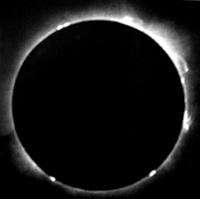Solar Saros 137 on:
[Wikipedia]
[Google]
[Amazon]




Saros cycle 137 - Information and visualization




Saros cycle
The saros () is a period of exactly 223 synodic months, approximately 6585.3211 days, or 18 years, 10, 11, or 12 days (depending on the number of leap years), and 8 hours, that can be used to predict eclipses of the Sun and Moon. One saros period ...
series 137 for solar eclipse
A solar eclipse occurs when the Moon passes between Earth and the Sun, thereby obscuring the view of the Sun from a small part of the Earth, totally or partially. Such an alignment occurs during an eclipse season, approximately every six month ...
s occurs at the Moon's ascending node. It repeats every 18 years, 11 days, and contains 70 events. 55 of these are umbral eclipses and other 15 of these are partial solar eclipses. All eclipses in this series occurs at the Moon's ascending node.
This solar saros is linked to Lunar Saros 130.
Saros 137
It is a part of Saros cycle 137, repeating every 18 years, 11 days, containing 70 events. The series started with partial solar eclipse on May 25, 1389. It contains total eclipses from August 20, 1533 through December 6, 1695, first set of hybrid eclipses from December 17, 1713 through February 11, 1804, first set of annular eclipses from February 21, 1822 through March 25, 1876, second set of hybrid eclipses from April 6, 1894 through April 28, 1930, and second set of annular eclipses from May 9, 1948 through April 13, 2507. The series ends at member 70 as a partial eclipse on June 28, 2633. The longest duration of totality was 2 minutes, 55 seconds on September 10, 1569. Solar Saros 137 has 55 umbral eclipses from August 20, 1533 through April 13, 2507 (973.62 years).Summary
Solar Saros series 137, repeating every 18 years and 11 days, has a total of 70 solar eclipse events including 12 central solar eclipses with a penumbral internal contact, between1948
Events January
* January 1
** The General Agreement on Tariffs and Trade (GATT) is inaugurated.
** The Constitution of New Jersey (later subject to amendment) goes into effect.
** The railways of Britain are nationalized, to form British ...
and 2146
In contemporary history, the third millennium of the anno Domini or Common Era in the Gregorian calendar is the current millennium spanning the years 2001 to 3000 ( 21st to 30th centuries). Ongoing futures studies seek to understand what is ...
. The penumbra northern limit started in 1948
Events January
* January 1
** The General Agreement on Tariffs and Trade (GATT) is inaugurated.
** The Constitution of New Jersey (later subject to amendment) goes into effect.
** The railways of Britain are nationalized, to form British ...
and will end on 2633, while the penumbra southern limit started in 1389
Year 1389 ( MCCCLXXXIX) was a common year starting on Friday (link will display full calendar) of the Julian calendar.
Events
January–December
* February 24 – Queen Margaret of Norway and Denmark defeats Albert, King of Swede ...
and will end in 2146
In contemporary history, the third millennium of the anno Domini or Common Era in the Gregorian calendar is the current millennium spanning the years 2001 to 3000 ( 21st to 30th centuries). Ongoing futures studies seek to understand what is ...
.
Umbral eclipses
Umbral eclipses (annular, total and hybrid) can be further classified as either: 1) Central (two limits), 2) Central (one limit) or 3) Non-Central (one limit). The statistical distribution of these classes in Saros series 137 appears in the following table.List of umbral eclipses
Solar Saros 137 has 55 umbral eclipses between 1533 and 2507. The total duration is almost one millennium, or about within 974 years. # 1533 # 1551 # 1569 # 1587 # 1605 # 1623 # 1641 # 1659 # 1677 # 1695 # 1713 # 1731 # 1750 # 1768 # 1786 # 1804 # 1822 # 1840 # 1858 # 1876 # 1894 # 1912 # 1930 # 1948 # 1966 # 1984 # 2002 # 2020 # 2038 # 2056 # 2074 # 2092 # 2110 # 2128 # 2146 # 2164 # 2182 # 2200 # 2218 # 2236 # 2254 # 2272 # 2290 # 2308 # 2326 # 2345 # 2363 # 2381 # 2399 # 2417 # 2435 # 2453 # 2471 # 2489 # 2507Events
External links
Saros cycle 137 - Information and visualization
References
* http://eclipse.gsfc.nasa.gov/SEsaros/SEsaros137.html {{Solar eclipses Solar saros series